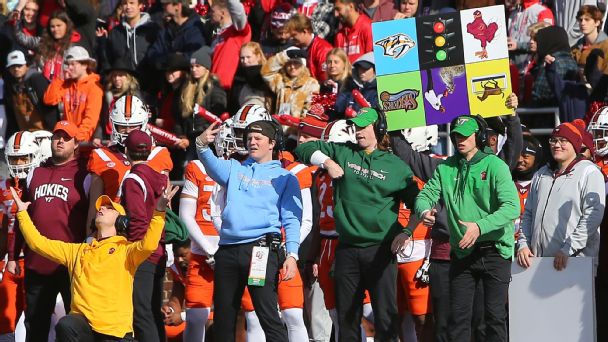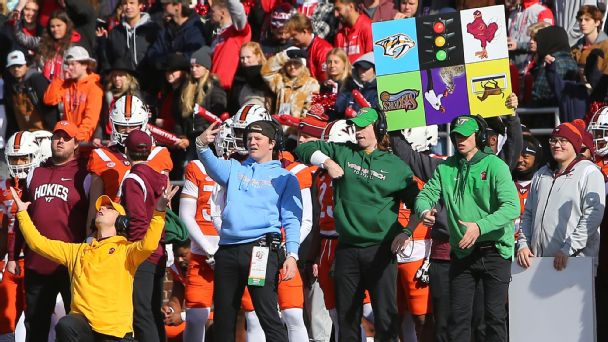
When Brent Pry was coaching the defense at Louisiana-Lafayette nearly 20 years ago, he had a habit of printing out an early draft of his game plan, scribbling notes and changes by hand, then making the needed changes to the documents. After he printed out the finished product, he’d tear up his first draft and toss it in his office garbage can.
As it happened, however, in one showdown against a rival — Pry isn’t telling which one — he found himself utterly perplexed by the opponent’s uncanny ability to predict exactly what play he’d just signaled to his players. Down after down, the rival was running plays that were at stark odds with the overwhelming tendencies Pry had studied all week. Pry’s staff was baffled.
“It was like they were in our headsets,” said Pry, now the head coach at Virginia Tech.
The day after the game, cleaning crews made their way through the visiting locker room, and lo and behold, there was Pry’s original game script, taped back together.
The other team’s staff wasn’t listening in on Pry’s headset, but it absolutely knew every play that was coming.
“They’d gone through our trash on Friday night,” Pry said. “They found it and put it back together.”
The recent allegations that Michigan had its own covert operative spying on other teams to crack the code for play signals has the college football world abuzz, but the truth is, sign stealing — and some outright Rube Goldberg-like plots to do it — is as deeply rooted in the fabric of college football as the tempo offenses that made the process chic.
Michigan’s alleged schemes might have broken specific NCAA rules against in-person scouting and using technology to tape opponents, but the quest to get a leg up by having a little inside information is ubiquitous and, according to many coaches, just a normal and acceptable part of the game.
“If you play someone who’s not picking signals,” one coach said, “it’s like, ‘Ah, this is so refreshing.’ It’s like the 1990s again.”
In the old days — i.e., any time before tempo schemes became all the rage in the early 2000s — signals from the sideline weren’t all that common, because substitutions allowed a player to carry a call from the sideline to the huddle. But as coaches looked for ways to move faster between plays, signals became the default communication strategy — and stealing those signals became a required talent for most top coordinators.
The outgrowth of the endless quest to crack the opponent’s code is a cat-and-mouse game between offense and defense and often plays itself out in increments of 40 seconds or less between snaps.
“The offense has one inherent advantage,” a longtime defensive coach said. “It controls when the play begins.”
Against a no-huddle, tempo system, which creates a dilemma for the defense, and a game of spy vs. spy begins.
In one scenario, the offense can signal in a formation, but not a play. The offense then lines up as if it plans to snap the ball, forcing the defense to signal in its play. Once the offensive staff gets a look at the defensive formation, it can signal in a play designed to maximize success against that defensive alignment. This, a coach said, makes simply knowing when a play is signaled in — not even what the play is, specifically — extremely valuable.
The alternative for the defense is to use wristbands with predesigned plays inscribed, allowing for a quick response to the offense’s formation without coaches signaling in a play from the sideline. But offenses can counter this, too, by deciding to increase tempo and snap the ball quickly, while defenders are still busy staring at their wrists to determine their playcall.
In either case, there’s a massive value in understanding what, exactly, the opponent has planned.
For some teams, that means near chaos on the sideline as a play is being signaled in, with three or four or a dozen graduate assistants or backup quarterbacks, clad in various bright colors, holding signs, waving hands, shimmying their hips, all in an effort to confuse the opposition.
“Everybody’s stealing signals on game day,” said NC State coach Dave Doeren. “Wristbands, you huddle, you change up who the live signalers are week to week so they’re not repetitive where teams can call each other and find out what they were. There’s a lot of ways you can do all that, but the way I look at it is, it’s on us as coaches, just like baseball, to change up signals all the time. It’s just part of the deal.”
Ah, yes, baseball, a sport that was rocked by a sign-stealing controversy, too, when the Houston Astros were discovered to be operating a sophisticated espionage operation using high-tech electronic surveillance equipment and low-tech trash cans for banging out signals to alert batters as to what pitch was coming. Those guys know a thing or two about protecting signals.
“Most people in baseball laugh at what’s going on in football now,” said one longtime MLB manager. “Make better signs! If somebody’s stealing your signs, you’ve got s—ty signs.”
In baseball, scouting opponents the way Michigan allegedly has — in person, with notebooks and cameras — is entirely legal, which makes switching up signs and disguising “live” signals from “dummy” signs an imperative.
“You change signs sometimes from inning to inning,” the manager said.
Football coaches attempt to do the same, but the frequency, and the results, may vary.
Pry said self-scouting is standard operating procedure to avoid having signals picked. When he was a coordinator at Penn State a few years ago, his staff got word its signals were known by a few opponents, so during the offseason, the Nittany Lions undertook a full overhaul.
“We had some guys take a look at us and see if they could nail down the live signaler and how easy it was to steal from us,” he said.” It was a whole offseason study to foolproof our system as best we could.”
The problem, Wake Forest head coach Dave Clawson said, is there’s no perfect plan.
“You change up what the signs are from week to week,” said Clawson, who for years early in his tenure in Winston-Salem had a Demon Deacons radio broadcaster supplying plays to the opposition. “You have multiple signs for the same call. You try to have dummy signalers. You change up wristbands by the series or by quarter. We’re extremely conscious of that ever since we went through those three years where people didn’t have signals, they had plays. You have to be very proactive with that stuff. But nothing is foolproof.”
One problem is simple information overload. There are numerous examples of teams using wristbands to avoid signal stealing, only to have players don the wrong ones. (Notable given Michigan’s place in the headlines: One assistant who spoke to ESPN said his team switched to wristbands against Ohio State because they were aware the Buckeyes were particularly adept at getting signals.)
Having a half-dozen signalers on the sideline or a constantly changing indicator for “live” plays vs. “dummy” ones risks misinterpretation. Numerous coaches recounted incidents of players reading the wrong signal, and 10 guys running the right play but the intended target of the pass running another. Changing signals frequently is its own challenge when upwards of 100 players need to learn those new signals.
And as a Big Ten assistant said, there’s only so many ways you can wiggle and so many grad assistants who can stand on the sideline holding up play cards.
Coaches can try to simply obstruct the view of the opposition, too, with towels or tarps, but when signaling in a play to an offense at midfield, there’s almost always a good vantage point from the other sideline.
“At some point, you’re going to get picked,” the defensive coordinator said.
Particularly against schools with smaller staff sizes and less money to spend on subterfuge, it can be downright simple to decipher the code.
“I’ve been in games earlier in my career where we had another team picked in the second quarter,” Clawson said. “It was easy. Every time he brought a blitz, his arms were going up and down.”
On the other hand, Clawson noted he once had an opposing school reach out to a former Wake equipment manager during the offseason and ask for insight on the Deacons’ signals. The school had a handful of support staff whose entire job during the offseason was to crack the signals for every opponent it would play the following year.
Scouring TV copies that show the opponent’s sidelines, calling friends on other staffs, hiring former support staff for a one-week debriefing session — it’s all fair game, and it all happens routinely.
Of course, there might be an easy alternative to the constant cat-and-mouse game: A speaker inside the helmet, something common to the NFL for decades but long avoided in the college ranks, though it will get a test run in some postseason games this year.
How long? Well, here’s what former Florida coach Steve Spurrier had to say when he resigned to take a job in the NFL in 2002.
“One thing I would look forward to is calling the plays in the microphone that go to the helmet,” he said. “I don’t have to get everybody to hide the signals. Gosh, you know how much a pain that is playing Tennessee and FSU 12 straight years, and they know all the signals? You got to get a guy to hide here and hide there. That would be smart if college football would do that, but I doubt if they will. Something smart is not always part of the logic.”
On the other hand, college football’s reticence to embrace technology affords coaches a chance to dabble in a little counterespionage that even Spurrier would likely appreciate.
“The real power,” the baseball manager said, “is in knowing something they don’t know you know. If I thought Michigan had our signs, I would set them up and I would abuse them.”
Clawson said he has left fake wristbands behind after walkthroughs before, allowing the opposition to discover it and be forced to decide whether the information is genuine or not.
A defensive coordinator, who asked to remain anonymous, once guessed the opposition had his signals, so he told his players to run a base scheme on the first three plays no matter what, then signaled in a bunch of more convoluted plays. Sure enough, the other team ran exactly the right offensive play … for the defensive play it thought was coming. That, the coordinator said, was a particularly rewarding three-and-out.
When Mike Leach was working as an offensive coordinator at Oklahoma in 1999, he purposefully left behind a fake script for the Sooners’ opening drive before a showdown with rival Texas, hoping the Longhorns would find it.
While Leach wasn’t above a little subterfuge of his own, one of his former assistants said he rarely saw value in adjusting his signs.
Indeed, the former assistant said, Leach didn’t even change his signals when he first arrived as head coach at Texas Tech, using many of the same signs he’d used the year before at Oklahoma — which made for an interesting matchup when Leach’s new team faced off against his old one.
“We’d have players every year that would come off the field and say, ‘They know the plays!'” the former assistant recalled. “I’d say, ‘Mike, they know the plays,’ and he’d say, ‘I don’t care, they can’t stop us.’ Then I’d say, ‘But Mike, it’s better if they don’t know the plays.'” And that, ultimately, gets at the heart of what makes signaling and stealing signals and adjusting to stolen signals and adjusting to the adjustments so ephemeral when it comes to impacting the actual outcomes.
For the 11 full-time coaches on the field, Pry said, it’s easy enough to get a sense your signs are picked or, perhaps, pick some of the other team’s tendencies. But to go any deeper than vibes requires a small army of support staff and a few dozen players who are capable of rolling with changes.
At some point, simplicity can simply outweigh all the gamesmanship as a means of gaining an advantage.
“We don’t have eight billboards and 15 guys wearing rainbow jerseys on the sideline,” Clemson quarterback Cade Klubnik said. “We’ve got a guy doing it, and I’m [reading] it. We make it efficient and quick and get rolling. At the end of the day, if someone finds our signs, they can know our play but they’ve still got to stop it.”
It brings to mind a story about Bobby Bowden’s great Florida State teams of the 1980s and ’90s. Around Tallahassee, there’s a deep-rooted belief the story comes from rival Miami, but it was chronicled in Mike Freeman’s biography of the late Seminoles coach, “Bowden: How Bobby Bowden Forged a Football Dynasty.”
In the book, Freeman quotes an anonymous coach, who fesses up to some particularly devious measures to get into Bowden’s head.
“We did some things I regret to this day,” the coach said.
They sent spies to Florida State’s practices, and they put microphones in the visiting locker room at their stadium. They got inside info on trick plays FSU planned to run, and they listened in on Bowden’s pregame speech and halftime adjustments. The coach guessed he probably had 30% to 40% of the Seminoles’ plays from cheating.
“But you know what?” the coach told Freeman. “We still lost. We wired Bobby Bowden’s locker room and still lost.”










